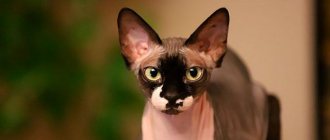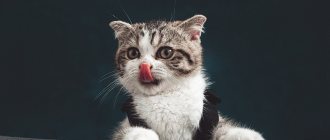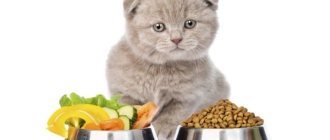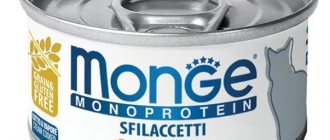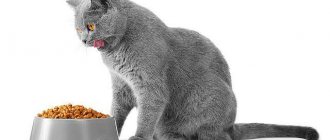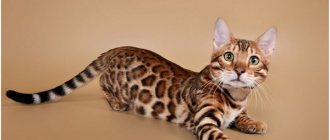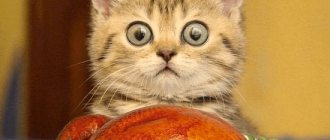Dietary features of sphinxes
The group of hairless cats includes not only the Canadian and Don Sphynxes, but also the breeds bred with their participation:
- Peterbald;
- Ukrainian Levkoy;
- bambino;
- Minskina;
- elf;
- Dwelf.
The nutritional rules are the same for all hairless breeds.
These animals are very different in many respects, but they are united by a complete or partial absence of hair. This feature dictates certain rules for keeping and feeding “bald cats”.
What can't you feed?
A pet of this breed should not be allowed to eat pork.
Don Sphynxes should not eat the following foods:
- Bird and fish bones.
- Meat: pork;
- duck;
- mutton;
- goose meat
What does the diet for sphinxes depend on?
Due to the lack of a warm fur coat, the Sphynx has to spend more calories on heating itself than any other cat. Representatives of hairless breeds have an excellent appetite, and their menu should be very satisfying and energetic. Organize feeding so that the pet receives only high-quality products, and the diet is strictly observed.
From age
The sphinx, like any living creature, has three ages: childhood, maturity and old age. There is a lot to do with this, including the feeding regimen and calorie content. A fast-growing kitten aged from one month to six months should receive the most high-calorie food, but at the same time not depressing its internal organs, initially six times a day, and by the time the teeth are completely replaced - four times a day.
An adult animal, depending on its activity and physical condition, can “eat” two or three times a day; these same parameters (plus health) must be taken into account when compiling the food range. In old age, it is better to switch the sphinxes to a children's, fractional regimen - many servings in small doses, gradually reducing the calorie content of the diet and increasing its medicinal component.
There is a common theory according to which the daily dose of food for a Sphynx should be equal to five percent of its body weight. This is not only a stupid, but also a harmful invention - according to this logic, an animal with severe obesity will eat a huge portion and continue to gain weight, which is completely unacceptable for it.
From the floor
A cat and a female cat should normally eat the same food - the calculation of the quality and quantity of food does not depend on the sex of the animal. But at the moments when the reproductive function is realized, the approach should be completely different.
During the period of preparation for mating (a month or two before the planned meeting), both partners should be switched to a high-protein diet, and the content of carbohydrates and fats should be reduced. When the female becomes pregnant, she will receive “special food” for the pregnant woman, but there is also an important point here. About a week before giving birth, you need to take care of the prevention of such a dangerous disease as eclampsia (milk fever is caused by a disorder of calcium metabolism - hypocalcemia, that is, a low level of this mineral in the blood of a cat). To prevent the disease, you should minimize the share of meat in the mother’s menu, and instead introduce foods with a high content of natural calcium.
A cat in an interesting position requires a special approach to feeding
From health status
Veterinary foods are called that because they, like medicines, should only be prescribed by a doctor - to each cat individually, after assessing the state of its health. Not a pet store salesperson, not an owner in his own right, and not even an experienced breeder - just a doctor who observes the animal.
The following are considered the best medicinal feeds:
- GO Sensitivity Shine - to normalize digestion;
- 1st Choice Urinary Health - for urolithiasis;
- Gina Elite Cat Sensitive - for sensitive animals prone to allergies;
- Josera SensiCat - for cats with digestive problems;
- Bozita Feline Funktion Sensitive Diet & Stomach - for sensitive digestion and obesity;
- Hill's Science Plan Sensitive Stomach - for cats with sensitive stomachs and skin;
- Royal Canin Sensible 33 - for cats with a sensitive digestive system.
From the physiological state
Pregnancy and lactation are perhaps the most important periods in a cat’s life. At this time, you need to pay special attention to its diet, make sure that the animal receives all the necessary elements not only to maintain its own physical shape, but also for the correct, harmonious formation of kittens.
The world's best brands recommend special food for mother cats, but with the same success, some breeders feed pregnant and lactating female cats with starters, which are intended for the smallest kittens and are rich in valuable, easily digestible components.
During the period of feeding kittens, the cat is entitled to an enhanced diet
. Castrated or sterilized pets should not be regarded as sick animals. But when selecting their regular menu, this special physiological state must be taken into account in order to control optimal weight and reduce the risk of developing urolithiasis. For sterilized and neutered Sphynx cats, we recommend the following foods:
- Hill's Science Plan Sterilized Cat;
- Eukanuba Adult Sterilized/Weight Control;
- Almo Nature Holistic Adult Cat Adult Beef and Rice;
- Bosch Sanabelle Sterilized;
- Royal Canin Neutered Young Female;
- 1st Choice Sterilized.
Choosing a bowl
The bowl should be comfortable, safe and practical. Ceramics fully meets these requirements. Such bowls are easy to clean and do not slide on the floor when the cat eats.
But ceramics is a rather fragile material. An alternative option is stainless steel cookware. But since metal bowls can slide on the floor, they need to be placed on a special stand.
Better yet, purchase an automatic cat feeder. In this case, you will always be sure that your pet is not only fed correctly, but also on time, even in your absence.
It wouldn’t hurt to add a special automatic waterer to the kit so that the cat is constantly provided with fresh water, filtered from contaminants.
What is prohibited in the diet of sphinxes
The omnivorous nature of sphinxes is absolutely no reason to feed them anything (and especially human food) or feed them treats from the master’s table; Such food is not only harmful, but also dangerous for hairless cats.
Food from the master's table is taboo for the Sphinx
The list of foods prohibited for sphinxes is quite long. Here are his main positions:
- any confectionery and yeast baked goods;
- fried, salted or smoked foods;
- pork;
- excess fat or added spices;
- river fish, especially raw;
- liver;
- legumes;
- citrus.
Unfortunately, it is impossible to recommend any specific food or nutrition system in general to an animal “behind the eyes”. Often you have to select an individual diet through trial and error - some things won’t suit your pet, and some things you absolutely won’t like. When switching from one food to another, it is extremely important for sphinxes to be gradual - a sudden change in menu can greatly harm digestion.
The transition from feed to feed should occur gradually, over ten days.
Care
Before discussing feeding a cat, let us recall the basic rules of care, because feeding and care are “links of the same chain”:
- For skin care, we use alcohol-free wipes or special shampoos and creams.
- A cat's eyes do not have eyelashes, so they are extremely vulnerable - we simply wipe them with boiled water, chamomile decoction, or tea leaves.
- To prevent the appearance of plaque, we use special food and brush our teeth with a special brush. You can give your cat chicken necks - they do the job perfectly.
- We clean the cat's ears weekly with a cotton swab. We use special powder.
- We regularly remove the transparent ends of the cat's claws.
- We remove the fat secreted by the tail glands - treat the cat's tail with degreasing agents.
- You should bathe your cat often - twice a month, using special shampoos.
- Particular attention is paid to the care of kittens. They are afraid of the cold, so the room temperature should be about 25 degrees. You can buy or sew clothes for a kitten - it will protect you from the cold and it will be “cool” for the kids.
- You need to play with your little ones so that they don't have fun on their own - you won't like spilled rubbish, torn curtains or overturned flower pots!
Problems with improper feeding
The criterion “does my cat like it” should not determine the choice of food for feeding the Sphynx, who is ready to eat anything without thinking about the consequences. And they can be very unpleasant:
- systemic digestive disorders;
- chronic diseases of internal organs;
- metabolic disorders;
- allergies and various dermatological diseases.
A Sphinx who eats at the same table with you should not cause tenderness, but anxiety
Overeating is detrimental for any cat, and for the Sphynx, whose sense of fullness is muted, it is especially dangerous. Hairless cats very easily experience metabolic failures, and metabolic disorders lead to obesity, which is fraught with quite serious problems - from acne to functional disorders of all body systems.
Choosing a place and dishes
The pet’s health and appetite are affected by both the food itself and the arrangement of the dining area. Choosing a place and dishes is an important undertaking. It’s better to think about this before purchasing a pet. Recommendations for the feeding area:
- place easy-to-clean material under the bowls, as you will need to constantly monitor cleanliness;
- provide free space and access to the site;
- place bowls away from loud household items (washing machine, TV);
- take into account the comfort of your pet - cats do not like to eat when someone is constantly walking nearby, so it is better to arrange a place away from the aisles.
If there are other animals in the house, feeding areas are provided for each pet. The cat will be malnourished without a sense of comfort and security.
The basic requirements for cookware are practicality, safety of materials, and convenience. Bowls allowed:
- made of ceramics - easy to clean and wash, do not slip, but can break;
- stainless steel is a good replacement, but these bowls should only be placed on a stand due to strong sliding.
What feed is best to use?
You cannot save on food for sphinxes - this will result in loss of health, and subsequently money for treatment. Expensive food is purchased for these cats not based on the prestige of the breed, but on the basis of their special susceptibility to poor quality nutrition. Almost all Sphynx cats are prone to allergies and have a very sensitive digestive system.
For kittens
Sphynxes are often prolific; their litters can contain six to eight, and sometimes up to twelve, completely viable kittens. It is clear that it is problematic for a cat to feed such a number of offspring on its own. In such cases, you should support her by feeding babies from the nipple with cat milk substitutes - such mixtures are offered in the lines of some food manufacturers.
Small Sphynx cats require more energy for normal development than babies of other breeds.
Kittens begin their first feeding at three weeks of age, introducing new foods into the diet in small doses - no more than one per day. Traditionally, many owners start feeding their babies semolina porridge - but this is not the best option, because there is little benefit from such feeding: only excess weight and the risk of allergic reactions. Human baby food is also not suitable for feeding small sphinxes - primarily because of the sugar in its composition. Here are the recommended “dishes” if you want to feed your kittens natural food:
- boiled yolk;
- calcined curd;
- boiled or frozen meat (chicken, turkey, veal);
- boiled sea fish;
- well-cooked buckwheat and rice porridge;
- greens, vegetables, fruits.
Until three months of age, active babies should eat at least six times a day (one serving - 25 grams). By six months, you need to gradually reach the adult regimen and dosage - feeding two or three times a day, 40-50 grams at a time.
A Sphynx kitten needs high-quality, high-calorie nutrition.
It is difficult to independently build a balanced menu for a kitten that is growing and developing quickly. In this sense, high-quality ready-made food is convenient and reliable - pay attention to the following products from the best brands:
- Royal Canin Babycat Instinctive - mousse for kittens up to 4 months;
- Royal Canin Kitten - dry food for kittens from 4 to 12 months;
- Purina Pro Plan Junior Chicken - canned food for kittens with chicken;
- Wahre Liebe Junge - dry food for kittens with colostrum;
- Hills Cat Science Plan Kitten Tuna - dry food for kittens with tuna;
- GO! Sensitivity + Shine Duck Cat Recipe Limited Ingredient Diet, Grain Free - for kittens and cats with sensitive digestion.
Hairless Canadian or Don kitten at 2 months
Sphynx kittens are adopted at approximately 2 months of age. Until this time, they are breastfed and receive their first complementary foods.
The owner needs to decide on the type of feeding - choose natural or wet food or dry food. If preference is given to the latter option, then special premium and higher class food is purchased, intended specifically for kittens. Before giving, the granules must be softened in advance with water.
Many premium manufacturers offer wet food. The feeding rate is indicated on the packaging.
But for the first days after the move, the kitten continues to be fed what it received at the breeder’s house. A change of place of residence and the absence of a mother is extremely stressful for a pet, and a change in its usual diet will only increase it. New nutrition is introduced gradually. The intestines will be completely rebuilt within a week, and will absorb food that is unusual for it in full.
If the new owner does not know what the kitten was fed by the breeder, then you can follow the standard recommendations. The menu should include:
- ground veal – boiled or well frozen and scalded;
- cottage cheese;
- egg yolk;
- a mixture of meat and vegetables in the form of a pate.
At 2 months of age, a kitten should eat up to 6-8 times a day, in small portions. Therefore, you will have to feed him at night, if necessary. This regimen must be maintained until 4 months of age.
Ragdoll cat breed, description of colors and photos, as well as their character, standards and sizes
The average volume of one serving for a 2-month-old Sphinx is 25 g. It can be increased or decreased. The owner makes adjustments independently, focusing on the physical condition and activity of the kitten.
At the age of 2 - 3 months, calcined cottage cheese, vegetables, spinach, unsalted cheese and sour milk are gradually added to the menu.
Advice! It is advisable to give fermented milk as an independent dish, for example, during an afternoon snack.
And the Canadian Sphynx, and the Don, and the Dwelf, and the Cohons, and the Minskin, and the Bambino, and the Ukrainian Levkoy, and the Elf have a sensitive stomach, so all uneaten food should be thrown away immediately so that it does not become a source for the growth of bacteria and the cause of food poisoning.
Clean water, which must be renewed at least once a day, should always be freely available. Otherwise, the kitten may experience constipation and develop dehydration.
Natural menu
Any cat is a carnivore, and protein should form the basis of its diet. If you are a supporter of a natural diet, then it will need to be built around meat and fish - these products will occupy at least 70 percent of the total volume.
But even the freshest and highest quality meat cannot be the only component of the Sphinx’s diet - the pet’s daily diet can be built from the following products:
- frozen beef or turkey meat - 40 g daily;
- boiled chicken breast without skin or boiled fish without bones - 3-4 times a week;
- boiled or frozen chicken offal (except liver), raw or boiled vegetables, fruits, herbs - 2-3 times a week;
- pharmaceutical brewer's yeast - 3-4 times a week;
- steamed oatmeal, buckwheat or rice - 2-3 times a week;
- chicken yolk, cheese - once a week;
- chicken neck or crackers - once a week (to cleanse teeth);
- vegetable oil (add a little to prepared food).
Be careful with red fruits - they can cause allergies in your Sphynx
What to feed a pregnant cat?
Feeding Sphynx cats during pregnancy depends on the pet's body weight, age and activity. An adult cat weighing 4 kg needs to receive 320-350 kcal every day. During pregnancy, the daily norm increases to 1200 kcal. A pregnant cat needs to be fed at least 4 times daily. The animal must receive raw meat (preferably beef).
Sphynxes should be given milk and dairy products after their main meal.
It is not advisable for a cat to eat fish. 20 days before giving birth, it is recommended to include nettles treated with boiling water in the menu. Eating boiled cereals and vegetables is beneficial. The food must contain bone meal. There is no need to overfeed your cat during pregnancy. This can trigger the development of obesity and complications during childbirth. There are various foods available for pregnant cats. It is important to familiarize yourself with the composition and choose a good product for your animal from the holistic or premium (super-premium) class.
Are additional beneficial supplements required?
By feeding the Sphynx with high-quality complete food, the owner does not have to worry about any additional feeding - the animal gets everything it needs without it. For cats that eat natural food, vitamin and mineral supplements are required - their composition and dosage should be recommended by a veterinarian, taking into account the characteristics of a particular animal and its diet.
Sphynxes are not only famous gluttons, but also sophisticated gourmets. Many of these breeds of cats love leafy greens, which are rich in vitamins and minerals. You should not deny your pet this healthy treat, even if you think that his diet is completely balanced and full of everything he needs.
Many bald cats generally have a weakness for fresh greenery - even for ordinary lawn grass, which is usually recommended for breeds with long and thick hair, in order to clear the cat’s stomach of its stray clumps. But don’t forget that your Sphynx could also use this cleansing and vitamin natural supplement.
Let him nibble the grass rather than eat your indoor plants - especially since among them there may be specimens that are dangerous to the cat.
Is it possible to have different types at the same time?
When choosing food for a cat of this breed, you need to give preference to one type of food: either dry, wet, or natural. It is extremely undesirable to practice feeding two different species at the same time, since the Sphinx’s digestive system is not adapted to rapid adjustment.
Warning! If, nevertheless, the decision on a mixed diet is made, then “drying” is offered in the morning, and natural food in the evening. The order can be changed.
Also, you cannot mix “drying” from different manufacturers. Each manufacturer uses their own proportions and ingredients, and also gives specific recommendations on standards. When mixing granules of different compositions, there is no question of a balanced diet.
Stainless steel bowl
Recipes for natural delicacies
You can pamper your pet sphinx by preparing the following “yummy”:
- Lightly boil chicken meat (1 kg) so that the top is cooked and the inside remains raw. Pass the meat together with cartilage, but without bones, through a meat grinder.
- You need to boil 2 chicken eggs. Remove the white and chop the yolk. Mix with minced meat. For the resulting amount of meat you will need to add: 25 ml of vitamin E, 50 ml of a mixture of B vitamins, 20 ml of taurine and fish oil. Mix these ingredients in 150 ml of water and pour into the minced meat. Divide the resulting mixture into single portions and store in the freezer. Before feeding, warm up to a comfortable temperature in the microwave.
A small amount of additives is mixed into the minced meat (no more than 25-30%). Chopped and boiled cereals (15%) - buckwheat, rice, egg, oatmeal - are suitable for this purpose. For variety, boiled or fresh vegetables, crushed to a puree, are added to the meat (10-15%):
- carrots rich in carotene;
- zucchini, which saturates the body with elements such as potassium, magnesium and manganese;
- fresh cucumbers. Some felines love them very much because they are very watery and allow you to get drunk on a hot summer day;
- pumpkin is useful both raw and boiled. Cats love to eat it even without meat. The dish is useful because it has an anthelmintic effect;
- broccoli – it contains antioxidants that slow down the aging process;
- asparagus is a vitamin plant that improves digestion due to its high fiber content;
- green beans - especially green beans contain a large supply of fiber. Cats eat it fresh with pleasure;
- celery – rich in vitamins and minerals important for a complete diet;
- melon - many sphinxes adore its taste and aroma. It is given in small portions, peeled and seeds removed.
It is rare, but it is allowed to pamper your pet with fish delicacies. For example, chopped and boned salmon is mixed with steamed rice in a ratio of 9:1 (90 g of fish will take 10 g of porridge). The mixture is diluted with boiled water to the consistency of a thick soup.
You can make oatmeal with tuna. To do this, the fish is boiled, cleaned and passed through a meat grinder. Oatmeal is added in small quantities to minced fish. All ingredients are thoroughly mixed. If you prepare for future use, you can place portions into individual containers and freeze the dish. Be sure to reheat before serving.
